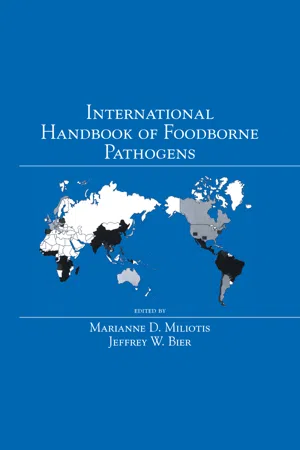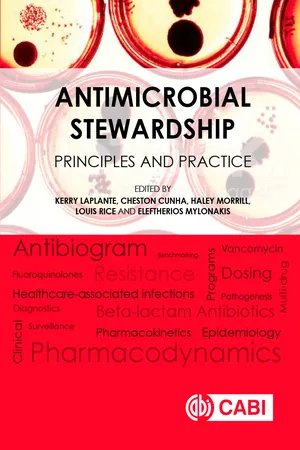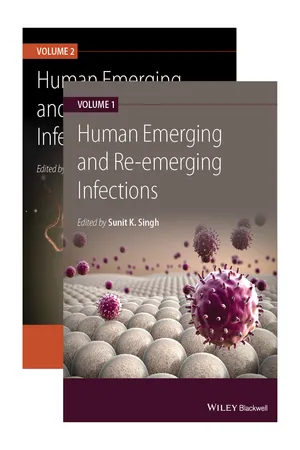Biological Sciences
S Aureus
S. aureus, or Staphylococcus aureus, is a bacterium commonly found on the skin and in the nasal passages of humans. It can cause a range of infections, from minor skin infections to more serious conditions like pneumonia and bloodstream infections. S. aureus is known for its ability to develop resistance to antibiotics, making it a significant public health concern.
Written by Perlego with AI-assistance
Related key terms
6 Key excerpts on "S Aureus"
- eBook - ePub
- Marianne D. Miliotis, Jeffrey W. Bier(Authors)
- 2003(Publication Date)
- CRC Press(Publisher)
The methods for identifying enterotoxins involve the use of specific antibodies. The fact that there are several antigenically different enterotoxins complicates their identification because each one must be assayed for separately. Another problem is that unidentified enterotoxins exist for which antibodies are not available for in vitro serology. These unidentified toxins, however, appear to be responsible for only a very small percentage of food-poisoning outbreaks.II. CHARACTERISTICS
A. Organism
S. aureus is a spherical gram-positive bacterium (coccus) that on microscopic examination appears in pairs, short chains, or bunched, grape-like clusters. Some strains are capable of producing a highly heat-stable protein toxin, which is capable of causing illness in humans. Other salient characteristics are that they are nonmotile and asporogenous; capsules may be present in young cultures but are generally absent in stationary phase cells (9 ). Staphylococcus species are aerobes or facultative anaerobes and have both respiratory and fermentative metabolism. They are catalase positive and utilize a wide variety of carbohydrates. Amino acids are required as nitrogen sources, and thiamine and nicotinic acid are also required. When grown anaerobically, they appear to require uracil (10 ).Although the staphylococci are mesophilic, some strains of S. aureus grow at a temperature as low as 6–7°C. In general, growth of S. aureus ranges from 7 to 47.8°C, with an optimum temperature for growth of 35°C. The pH range for growth is between 4.5 and 9.3, with the optimum between pH 7.0 and 7.5 (9 ). As is true with other parameters, the minimum pH for growth is also dependent on the degree to which all other parameters are at optimal conditions (10 ). With regard to water activity (Aw ), the staphylococci are unique in being able to grow at lower levels than other nonhalophilic bacteria. Growth has been demonstrated at as low as 0.83 Aw under ideal conditions. These low Aw conditions are too low for the growth of many competing organisms. Most strains of S. aureus are highly tolerant to the presence of salts and sugars and can grow over an Aw range of 0.83 to >0.99. S. aureus grows best at an Aw of >0.99, and growth at low Aw - eBook - ePub
Antimicrobial Stewardship
Principles and Practice
- Kerry LaPlante, Cheston Cunha, Haley Morrill, Louis Rice, Eleftherios Mylonakis(Authors)
- 2016(Publication Date)
- CAB International(Publisher)
S. aureus is a major cause of morbidity and mortality. It is the most virulent member of the genus Staphylococcus. Unlike other members of the genus, S. aureus is well endowed with a variety of virulence factors.Superficial and invasive S. aureus infections occur in previously healthy persons. Infections of the skin range from impetigo to abscess formation, cellulitis, or lymphadenitis, particularly of the cervical lymph nodes in children or adjacent to an infectious focus. S. aureus also may cause several important ocular infections, including conjunctivitis, preseptal cellulitis, and endophthalmitis. S. aureus is an important cause of endocarditis and is the leading cause of this in many regions of the world. (Bashore et al., 2006 ). The clinical manifestations may be particularly severe, and the infected heart valve may have been previously normal, especially when the mitral or aortic valves are involved. Pericarditis may be an isolated syndrome or may accompany endocarditis.Hematogenous seeding of a bone or joint may result in osteomyelitis, septic arthritis, or even bursitis. S. aureus is a cause of several respiratory tract infections, including an occasional otitis media and pneumonia. The latter may be a severe, necrotizing process with high mortality. Central nervous system (CNS) infections are infrequent and usually involve a surgically introduced portal of entry for the organism, such as extension from an infected sinus, a dermal sinus, or a meningomyelocele. CNS infectious syndromes also include subdural and epidural empyemas. A spinal epidural abscess adjacent to the dura may be caused by S. aureus too, especially in adults. Rarely, S. aureus may infect the urinary tract or be recovered from the urine of a patient with high-grade bacteremia or a renal abscess.S. aureus frequently complicates surgical procedures in which the integument was breached and medical interventions in which indwelling foreign bodies are used in management. The insertion of a plastic, metal, or Gore-Tex device provides an opportunity for S. aureus to persistently adhere. Success in removing the organism(s) from the inserted device has posed a great challenge, even when the isolate is susceptible to the antibiotic used. Thus, certain patients, such as those needing hemodialysis, those with indwelling venous catheterization, indwelling intravascular Gore-Tex patches, artificial prostheses, or cerebrospinal fluid flow diversionary devices, are at high risk of S. aureus - eBook - ePub
Food Microbiology
Fundamentals and Frontiers
- Michael P. Doyle, Francisco Diez-Gonzalez, Colin Hill(Authors)
- 2019(Publication Date)
- ASM Press(Publisher)
The association of staphylococci with foodborne illness was made more than a century ago. Barber, in 1914, was the first to implicate a toxin in SFP (1). He reported that repeated ingestion of contaminated milk produced symptoms typical of the illness. Barber cultured the milk, demonstrated the presence of a putative causative staphylococcal agent, and provided the first evidence that a soluble toxin was responsible for the disease. The next major advance in understanding SFP etiology was reported in 1930 by Dack et al. (2); Dack voluntarily consumed supernatant fluids from cultures of “a yellow hemolytic staphylococcus” grown from contaminated sponge cake. Upon ingestion of the filtrates, he became ill with vomiting, abdominal cramps, and diarrhea. At that time, the only other foodborne toxin that had been recognized was botulinum toxin. However, staphylococcal toxin, which exerted an effect on the gastrointestinal tract, was the first true enterotoxin described. It was particularly different from botulinum toxin because its activity was “not entirely destroyed by heating even for 30 minutes at 100°C.”S. aureus has been extensively characterized. This bacterium produces a variety of extracellular products. Many of these, including the SEs, are virulence factors which have been implicated in diseases of humans and animals. As a group, the SEs elaborate a set of biological properties that enable staphylococci to cause at least two common human diseases, toxic shock syndrome (TSS) and SFP. This chapter primarily addresses SFP; however, there is significant overlap in the histories of both diseases. Hence, TSS is also discussed in sections in which this overlap is most relevant.CHARACTERISICS OF THE ORGANISM
Taxonomy
The term “staphylococci” describes a group of small spherical, Gram-positive bacteria. Depending on the species and culture conditions, their cells have diameters ranging from approximately 0.5 to 1.5 μm. They are catalasepositive chemoorganotrophs with a DNA guanine-plus-cytosine content of 30 to 40 mol%. Staphylococci have a typical Gram-positive cell wall containing peptidoglycan and teichoic acids. Except for clinical isolates, such as some community-acquired methicillin-resistant S. aureus strains (3) and strains exposed to antimicrobial therapy, most staphylococci are sensitive to β-lactams, tetracyclines, macrolides, lincosamides, novobiocin, and chloramphenicol but are resistant to polymyxin and polyene. Some differential characteristics of S. aureus and several other selected species of staphylococci are summarized in Table 21.1 .There have been many useful schemes for classification of the staphylococci. According to Bergey’s Manual of Systematic Bacteriology (4), staphylococci are classified in the family Micrococcaceae. This family includes the genera Micrococcus, Staphylococcus, Stomatococcus, and Planococcus. The genus Staphylococcus is further subdivided into 53 species. Many of these are present in food as a result of human, animal, or environmental contamination. Several species of Staphylococcus, including both coagulase-negative and coagulase-positive isolates, can produce SEs. Although several species, including some coagulase-negative staphylococci, have the potential to cause gastroenteritis (5), nearly all cases of SFP are attributed to S. aureus. This is because of the relatively high prevalence of SE production by S. aureus in comparison to other staphylococcal species. Although the reason for this is unknown, the SEs are superantigens (SAgs) and therefore are potential immunomodulating agents (see below). Hence, SE production is proposed to provide a selective advantage to S. aureus - eBook - ePub
Microbiological Examination Methods of Food and Water
A Laboratory Manual, 2nd Edition
- Neusely da Silva, Marta H. Taniwaki, Valéria C.A. Junqueira, Neliane Silveira, Margarete Midori Okazaki, Renato Abeilar Romeiro Gomes(Authors)
- 2018(Publication Date)
- CRC Press(Publisher)
S. aureus subsp. aureus is usually called only S. aureus in the literature, without mention of the subspecies. According to Schleifer and Bell (2009b) it is facultative anaerobic but growth is best under aerobic conditions. Protein A is produced, and the positive reactions include alkaline phosphatase, coagulase, clumping factor, heat-stable nuclease (thermonuclease), hemolysin and lipase. Acid is produced aerobically from glucose and mannitol. The temperature range for growth is 10°C to 45°C and the optimum is 30°C to 37°C.S. aureus is not heat resistant, and is easily destroyed by pasteurization or by normal cooking. Enterotoxins, on the other hand, are highly heat resistant and survive heat treatments as severe as those used to sterilize low-acid foods (ICMSF, 1996).S. aureus is a salt-tolerant microorganism and, according to Schleifer and Bell (2009b), its growth is good in medium containing 10% of NaCl and poor at 15%. According to ICMSF (1996), it grows at a water activity as low as 0.85 (salt content 25% w/w). From this aspect, S. aureus is an atypical bacterium among the foodborne pathogens, which normally do not grow at such a low water activity.10.1.2 EpidemiologyAccording to Bien et al . (2011), S . aureus can cause a wide variety of infections, including wound infection, toxinoses (food poisoning, scalded skin syndrome, toxic shock syndrome) and systemic conditions (endocarditis, osteomyelitis, pneumonia, brain abscesses, meningitis, bacteremia).According to Schleifer and Bell (2009b), S. aureus was responsible for considerable morbidity and mortality among hospitalized patients from 1950 to 1960. Methicillin-resistant S. aureus (MRSA) strains emerged in 1980 and have become a great epidemio-logical problem in hospitals. Enterotoxin-producing S. aureus strains are the most common coagulase-positive staphylococci associated with food intoxication outbreaks.10.1.2.1 StaphylococcuS Aureus enterotoxinsS. aureus produces various types of toxins. The alpha, beta, delta and gamma toxins and the leukocidins are involved with cell lysis and tissue invasion (Ferry et al ., 2005). The exfoliative toxins (ETs, also known as “epidermolytic” toxins) are responsible for the staphylococcal scalded skin syndrome (disease characterized by the loss of superficial skin layers, dehydration and secondary infections) (Bukowski et al ., 2010). The toxic shock syndrome toxin (TSST-1) is responsible for the toxic shock syndrome (acute onset illness characterized by fever, rash formation and hypotension that can lead to multiple organ failure and lethal shock) (Ferry et al - eBook - ePub
- Vincent A. Fischetti, Richard P. Novick, Joseph J. Ferretti, Daniel A. Portnoy, Mirian Braunstein, Julian I. Rood(Authors)
- 2019(Publication Date)
- ASM Press(Publisher)
9 ).Despite the prevalence of literature characterizing staphylococcal pathogenesis in humans, S. aureus is a major cause of infection and disease in a plethora of animal hosts, leading to a significant impact on public health and agriculture (10 ). Infections in animals are deleterious to animal health, and animals can act as a reservoir for staphylococcal transmission to humans. While about 20 to 30% of the human population carries S. aureus , the prevalence of S. aureus varies from host species to host species, and up to 90% of chickens, 42% of pigs, 29% of sheep, and between 14 and 35% of cows and heifers are carriers (11 , 12 ). The economic importance of various animal species strongly determines the abundance of available literature on the subject, and as such, it is not surprising that S. aureus colonization and infection have only been superficially investigated in wild animals. Nevertheless, S. aureus has been isolated from a plethora of wildlife sources such as red squirrels (exudative dermatitis) (13 ), black bears (endocarditis) (14 ), zebras (cutaneous granuloma) (15 ), raccoons (botryomycosis) (16 ), dolphins (pyogenic meningoencephalitis) (17 ), harbor seals (systemic infections) (18 ), black rhinoceroses (skin lesion and sepsis) (19 ), boars (nasal carriage) (20 , 21 ), rhesus macaques (nasal carriage) (22 ), great apes (nasal carriage and sepsis) (23 ), chaffinches (healthy carriage) (24 ), mallards (sepsis) (25 ), red deer, griffon vultures, and Iberian ibex (carriage) (21 ).Animal isolates of S. aureus have been reported to exhibit distinct phenotypic properties that vary depending on the host of origin, and six biotypes have been described: human, β-hemolytic human, bovine, caprine, avian-abattoir, and non-host specific. These biotypes have, by and large, withstood the application of sophisticated characterization methods; isolates from different hosts, characterized by multilocus enzyme electrophoresis, cluster together, suggesting host specificity and a limited ability of strains to be transmitted from one host species to another (10 ). These observations were further corroborated by genotyping methods such as pulsed-field gel electrophoresis, and strains belonging to specific biotypes grouped in the same or closely related pulsotypes (26 - Sunit Kumar Singh(Author)
- 2015(Publication Date)
- Wiley-Blackwell(Publisher)
J. Infect. Dis., 201, 1414–1421.- Burian, M., Wolz, C., and Goerke, C. 2010b. Regulatory adaptation of StaphylococcuS Aureus during nasal colonization of humans. PLoS One, 5, e10040.
- Buyukcangaz, E., Velasco, V., Sherwood, J., Stepan, R., Koslofsky, R., and Logue, C. 2013. Molecular typing of StaphylococcuS Aureus and methicillin-resistant S. aureus (MRSA) isolated from animals and retail meat in North Dakota, United States. Foodborne Pathog. Dis., 10, 608–617.
- Cameron, D.R., Howden, B.P., and Peleg, A.Y. 2011. The interface between antibiotic resistance and virulence in StaphylococcuS Aureus and its impact upon clinical outcomes. Clin. Infect. Dis., 53, 576–582.
- Cañas-Pedrosa, A.M., Vindel, A., Artiles, F., Colino, E., and Lafarga, B. 2012. Antimicrobial resistance and molecular epidemiology of Panton-Valentine leukocidin–positive community-associated methicillin-resistant StaphylococcuS Aureus from Gran Canaria (Canary Islands, Spain). Diagn. Microbiol. Infect. Dis., 74, 432–434.
- Carpenter, C.F., and Chambers, H.F. 2004. Daptomycin: Another novel agent for treating infections due to drug-resistant Gram-positive pathogens. Clin. Infect. Dis., 38, 994–1000.
- Carter, N.J., and Scott, L.J. 2010. Besifloxacin ophthalmic suspension 0.6%. Drugs, 70, 83–97.
- Cary, S., Krishnan, M., Marion, T.N., and Silverman, G.J. 1999. The murine clan VH III related 7183, J606 and S107 and DNA4 families commonly encode for binding to a bacterial B cell superantigen. Mol. Immunol., 36, 769–776.
- CDC. 2003. Outbreaks of community-associated methicillin-resistant StaphylococcuS Aureus skin infections–Los Angeles County, California, 2002–2003. MMWR Morb. Mortal. Wkly. Rep., 52, 88–88.
- CDC. 2013. Methicillin-resistant StaphylococcuS Aureus (MRSA) infections.
- Chambers, H.F., and DeLeo, F.R. 2009. Waves of resistance: StaphylococcuS Aureus in the antibiotic era. Nat. Rev. Micro., 7, 629–641.
- Chambers, H.F., Korzeniowski, O.M., and Sande, M.A. 1983. StaphylococcuS Aureus endocarditis: Clinical manifestations in addicts and nonaddicts. Medicine
Learn about this page
Index pages curate the most relevant extracts from our library of academic textbooks. They’ve been created using an in-house natural language model (NLM), each adding context and meaning to key research topics.





